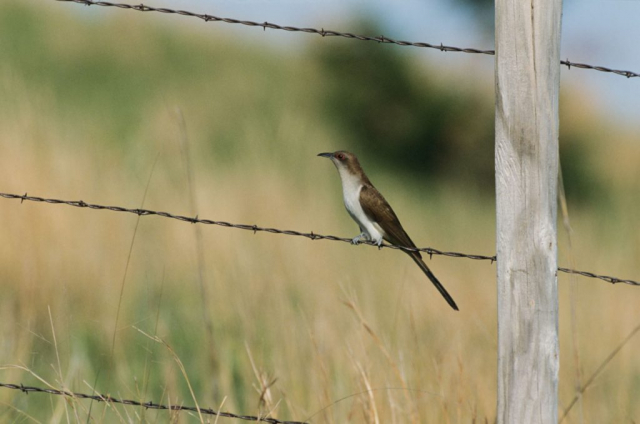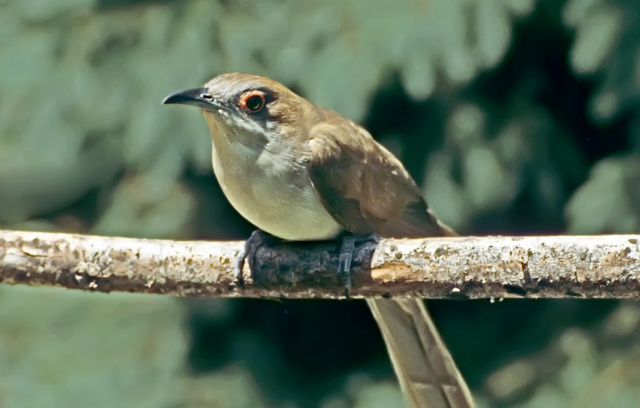Coccyzus erythropthalmus
Status: Decreasing. Rare regular breeder and spring and fall migrant east and central, rare casual west.

Documentation: Specimen: UNSM 6243, 6 Jul 1901 Warbonnet Canyon, Sioux Co.
Taxonomy: No subspecies are recognized (AviList 2025).
Spring: May 10, 11, 11 <<<>>> summer
Migrants appear in mid- to late May. Half of the spring arrival dates considered by Johnsgard (1980) were in the period 16-30 May.
A high count in Otoe Co 16 Jun (see below) suggests migration continues well into Jun.
There are only six spring records for the Panhandle: 22 May 2024 Dawes Co, 29 May 2025 Monroe Canyon, Sioux Co, 31 May 2026 Fort Robinson, Dawes Co, 2 Jun 206 Agate, Sioux Co, 13 Jun 2019 Sowbelly Canyon, Sioux Co, and 16 Jun 2019 Sowbelly Canyon.
- High counts: 7 in Otoe Co 16 Jun 2007, 5 there 31 May 2006, 3 at Blyburg Lake, Dakota Co 20 May 2000, 3 near Creighton, Knox Co 24 May 2002, and 3 at Fontenelle Forest, Sarpy Co 13 May 2011.
Summer: In Nebraska, this species is near the southwestern edge of its summer range, but at one time occurred statewide. Currently (2024), it is most often reported in the northeastern third of Nebraska and is less-than-annual in the west. This species prefers deeper or denser woodlands than Yellow-billed Cuckoo (Hughes 2020) and because those habitats are limited in Nebraska it is less common than that species, especially westward. In the Missouri River Valley, it tends to occur in interior forest with dense thickets for nesting. BBS data (2008-2012) indicate that few are reported away from the extreme southeast, although there are breeding records statewide (Ducey 1988).
An apparent decline since the 1960s may be a consequence of a northward shift of the breeding range since then, similar to other northward summer range shifts in Nebraska. BBS trend analysis shows a -5.29 (95% C.I.; -7.24, -3.34) decline during the period 1966-2015 (Sauer et al 2017). Mollhoff (2016) also noted a decline, from 23% to 7%, in the proportion of blocks this species was reported between the first (1984-1989) and second (2006-2011) BBA. Similar results have been reported in South Dakota (Drilling et al 2018). For Nebraska, in the 10 years 2015-2024, there were five reports in both 2014 and 2015, 1-3 (average 2) in the years 2017-2023, and a surprising 10 in 2024; of the total 33 records 2014-2023, 26 were in the north and east (eBird.org, accessed Aug 2024).
It has been suggested that declines in Nebraska and elsewhere are a result of extensive pesticide use reducing abundance of caterpillars (Hughes 2020). Short (1961) suggested that it may be “frequently overlooked,” as he found it common at Big Springs, a part of the state where it has been thought to be least numerous (Johnsgard 1979, 1980). Short’s observation may have been during a caterpillar outbreak, a phenomenon which may influence abundance of this species to a greater extent than for Yellow-billed Cuckoo (Rosche 1982). It was listed as uncommon at NNF Bessey, Thomas Co by Bray (1994), who suggested that this species had become less common than Yellow-billed Cuckoo since Zimmer noticed the opposite in 1912 (Zimmer 1913).
One was westerly at Smith Lake WMA, Sheridan Co during summer 2008 (Steven Jones, personal communication), and other reports for the Panhandle are 22 May 2024 Dawes Co, 31 May 2016 Dawes Co, 13-16 Jun 1919 Sioux Co, 2 Jun 2026 Sioux Co, 8 Aug 1996 Kimball Co, and 16 Aug 1971 Kimball Co.
- Breeding phenology:
Eggs: 25 May- 14 Aug (Mollhoff 2022)
Nestlings: 30 Jun-12 Jul
Fall: summer <<<>>> Sep 1, 1, 2
Departure is in Aug, with very few later dates: 7 Sep 2018 Douglas Co, 10 Sep 2020 juvenile Lancaster Co, 12-13 Sep 2020 adult Lancaster Co, 16 Sep 2024 Lancaster Co, 21 Sep 2020 juvenile Lancaster Co, and 27 Sep 2015 Thurston Co.
There are only two fall records for the Panhandle: 8 Aug 1996 Oliver Reservoir, Kimball Co, and 16 Aug 1971 near Exit 1 on I-80, Kimball Co.
Images
Abbreviations
BBA: Breeding Bird Atlas
BBS: Breeding Bird Survey
NNF: Nebraska National Forest
NOURC: Nebraska Ornithologists’ Union Records Committee
Acknowledgement
Photograph (top) of a Black-billed Cuckoo in Sarpy Co, 12 Jun 1984 by Phil Swanson.
Literature Cited
AviList Core Team, 2025. AviList: The Global Avian Checklist, v2025. https://doi.org/10.2173/avilist.v2025.
Bray, T.E. 1994. Habitat utilization by birds in a man-made forest in the Nebraska Sandhills. Master’s Thesis, University of Nebraska-Omaha, Omaha, Nebraska, USA.
Drilling, N.E., E.D Stukel, R.A. Sparks, and B.J. Woiderski. 2018. The Second Atlas of Breeding Birds of South Dakota. SDGFP, Wildlife Division Report 2017-02. South Dakota Game, Fish, and Parks, Pierre.
Ducey, J.E. 1988. Nebraska birds, breeding status and distribution. Simmons-Boardman Books, Omaha, Nebraska, USA.
Falk, L. 2002. Birds in Otoe County. Published by the author, Nebraska City, Nebraska, USA.
Hughes, J.M. 2020. Black-billed Cuckoo (Coccyzus erythropthalmus), version 1.0. In Birds of the World (P. G. Rodewald, Editor). Cornell Lab of Ornithology, Ithaca, NY, USA. https://doi.org/10.2173/bow.bkbcuc.01.
Johnsgard, P.A. 1979. Birds of the Great Plains: breeding species and their distribution. University of Nebraska Press, Lincoln, Nebraska, USA.
Johnsgard, P. A. 1980. A preliminary list of the birds of Nebraska and adjacent Great Plains states. Published by the author, University of Nebraska, Lincoln, USA.
Mollhoff, W.J. 2016. The Second Nebraska Breeding Bird Atlas. Bull. Univ. Nebraska State Museum Vol 29. University of Nebraska State Museum, Lincoln, Nebraska, USA.
Mollhoff, W.J. 2022. Nest records of Nebraska birds. Nebraska Ornithologists’ Union Occasional Paper Number 9.
Rosche, R.C. 1982. Birds of northwestern Nebraska and southwestern South Dakota, an annotated checklist. Cottonwood Press, Crawford, Nebraska, USA.
Short, L.L., Jr. 1961. Notes on bird distribution in the central Plains. NBR 29: 2-22.
Zimmer, J.T. 1913. Birds of the Thomas County Forest Preserve. Proceedings Nebraska Ornithologists’ Union 5: 51-104.
Recommended Citation
Silcock, W.R., and J.G. Jorgensen. 2025. Black-billed Cuckoo (Coccyzus erythropthalmus). In Birds of Nebraska — Online. www.BirdsofNebraska.org
Birds of Nebraska – Online
Updated 1 Aug 2025



